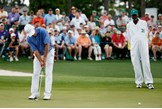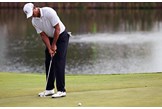Austrian Open champion Marc Warren: Everything I know about putting
Published: Last updated:
Marc Warren shares the putting philosophy that helped him to a fourth European Tour victory.
After a six-year wait, the 39-year-old Scotsman secured victory at the Diamond Country Club as the European Tour and Challenge Tour season returned from a four-month break due to Coronavirus, thanks largely to an exceptional performance on the greens with his Odyssey Prototype iX #1 and Callaway Chrome Soft X Triple Track ball.
Here, Warren shares everthing he knows about putting.
Related: Best Putters 2020
What is your basic philosophy for putting?
When I hear people say it is a ‘game within a game’ I do find myself nodding. It is different from the full swing. But I don’t think it is something people should be afraid of either. You can learn to love putting, just because it is so removed from the rest of the game.
Working on your putting certainly isn’t like standing on the range hitting balls, which pretty much everyone enjoys doing. There’s a lot of feel involved in good putting, as there is in the short game as a whole.
In short, putting involves a very different technique, method, skill set and mentality.
Related: Lower your scores with strategy tips from the world’s best golfers

So what is most important?
The key is balance. That’s an aspect of putting that is much over-looked, both front-to-back and left-to-right. In the full swing you have rotation, movement and weight transfer, but when I’m putting all I want is to be as steady as I can be. It is very difficult to make any kind of consistent movement when you are off-balance. I think of it as being ‘planted’ on the ground, or ‘heavy,’ as I like to call it. If you have that, maintaining your posture is a lot easier to do. And if you have that, consistency of pace, tempo and strike are much easier to achieve.
RELATED: Putting coach Phil Kenyon saves you six shots per round
So what is going through your head at address?
Inside my shoes, I lift my toes. That gets my weight on my heels and the balls of my feet. Which is not to say my weight is too far back. When you lean forward, the heaviest part of your body – your head – is forward. To counteract that, your backside has to go the other way. And when you go into any kind of motion, your instinct is to find your natural balance point. That means keeping your head perfectly still. If you look at the very best putters over the years – Tiger is a great example – their heads never move during the stroke. But that happens because he maintains balance and posture.

We all miss more putts than we hole. How do you deal with that psychologically?
I deal with it by blaming something other than myself. But mostly I am accepting. I know I can hit a perfect putt and it can still miss. On the other hand, I have hit many poor putts that have gone in. By knowing both – and saying them to myself often enough – I remove pressure from any putt. I have no expectation, which frees me up to hit a good putt and accept whatever happens.
Related: Balls test – Callaway Chrome Soft Triple Track vs TaylorMade TP5 Pix
Any other psychological tricks you can share?
I like to set my mind on something other than the result, too. I go to little thoughts and feels at address. Retaining the angle in my left wrist – ‘high’ is how I think of it – through impact is one I like. Or maintaining a little tension in my legs to maintain my posture. Just something I can focus on while the putt takes care of itself.
This is as much an art as a science, isn’t it?
Yes. It’s a blend of both. But, at least for me, too much science or technique is detrimental. I’ve overdone it at times. I like to have enough information. But really no more than that.
Related: How the Axis1 putter helped Justin Rose to his best year

Run through your stroke…
I like to stand square to the putt. But that isn’t a firm rule. Great putters have stood open or closed, so it is really about experimenting to see what suits you. Jack Nicklaus, for example, stood open (left foot drawn back) and tilted his head to look towards the hole. I practise with a chalk line or a piece of string to train my eyes to look right down the line. That’s so important when it comes to starting the ball on the track I want. Just as in the full swing, a bad position at address means you have to compensate later. That’s no way to be consistent.
What about your grip? How do you hold the putter?
The grip is so important, too. I like the shaft to run through the lifeline of both hands. I want my palms facing each other, with my thumbs side by side. That keeps the putter in line with my forearms and also encourages a proper arc in the stroke. I have no problem with a little wrist action in my stroke, either, especially on longer putts. To me, that helps with fluidity and removes any tendency to be too ‘stiff’.
I also find that, in turn, that makes judgment of distance easier.
Related: Best putter grips
Do you advocate the ‘straight back, straight through’ method?
No. I like my stroke to be on a natural arc – a bit like Ben Crenshaw, below – on both sides of the ball. It’s only a slight rotation of the putter on short putts, but for me that is the best way to keep the face square to the arc of the stroke. It just feels more natural. With ball position, I like it almost directly under my eyes, or a little outside. I’m not sure too many players have ever putted with the ball inside their eye lines.

Do you have any drills you like to use?
I pick a spot maybe six inches in front of the ball and try to ‘hit’ that every time. It sounds easy, but it’s great training and a great way to line up correctly. If I’m using a chalk line, I visualise that extending all way to the back of the hole. I’m definitely a ‘back of the hole’ guy. I read my putts on the low side so that I can be more aggressive.
Related: A-to-Z of putting
MARC WARREN’S 3 KEY PUTTING RULES
► GRIP THE PUTTER LIGHTLY
How you hold the club is so important. I like to grip every club pretty lightly, as if you are gently holding a small bird, and the putter is no exception.
Get the shaft of your putter running through the lifelines on both hands. That is the key to allowing the putter to swing on a natural arc without manipulation. Even if there is any breakdown in your wrist, it will do so ‘on line.’
► FOCUS ON GOOD BALANCE
I can’t over-emphasise the importance of good balance, which in turn leads to good posture and a minimum of moving parts throughout the stroke. When there is less going on, less can go wrong.
Think of it this way: if you are off-balance at address and the club moves back, you are going to have to move to regain your balance. That’s never good.
► ALIGNMENT AND ACCEPTANCE
Putts that come up short don’t often go in. Nor do those that start or finish off-line. The key is making sure the line you choose for the putt is actually where you are aiming. That eliminates one variable.
But don’t forget, even great putts struck perfectly on the perfect line sometimes miss. Golf has never been a fair game and putting epitomises that old adage.
Related: Odyssey Triple Track putter review





